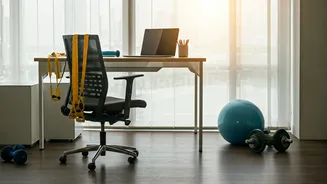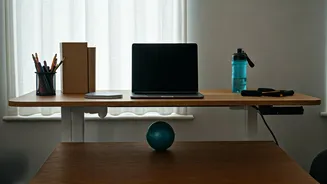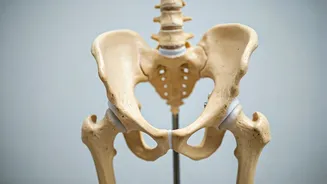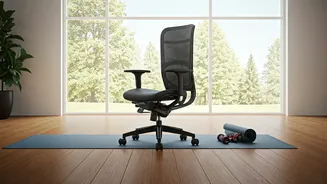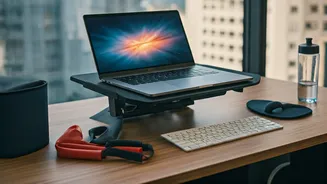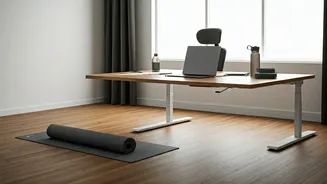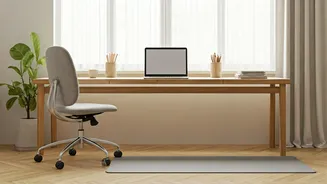Ankle Rolls & Circles
Start with your feet flat on the floor or slightly elevated if you are using an exercise ball. Begin with simple ankle rolls: slowly rotate each foot in a circular
motion, first clockwise, then counterclockwise. This movement improves circulation in the lower legs and ankles, which can reduce swelling and stiffness. Next, perform ankle circles. Lift one foot slightly off the floor and draw large circles with your toes, again, both clockwise and counterclockwise. Do this for roughly 30 seconds on each foot. These exercises are particularly useful after sitting for extended periods, as they help to prevent blood from pooling in the lower extremities. The gentle movement can also help alleviate any discomfort and keep your legs feeling fresh. Try them a few times during the workday to keep circulation moving and reduce fatigue.
Neck Tilts and Turns
Neck stretches are often overlooked, but they are crucial for relieving tension built up from looking at a computer screen for hours. Begin by gently tilting your head to the right, attempting to touch your right ear to your right shoulder. Hold this stretch for about 15 seconds, and then repeat on the left side. These side stretches help loosen the muscles in your neck and upper shoulders, which get tight when sitting for extended periods. Following the side tilts, try neck turns: slowly turn your head to the right as far as comfortable, holding for 15 seconds, then repeat on the left. This movement helps improve your range of motion and alleviates stiffness. This routine, when integrated into your day, will significantly reduce discomfort. Remember to move slowly and deliberately, ensuring you listen to your body and never force a stretch.
Shoulder Blade Squeezes
Shoulder blade squeezes offer a simple yet powerful exercise to address poor posture and alleviate upper back pain, commonly experienced by those sitting for long hours. Sit tall, maintaining a neutral spine, and relax your shoulders. Then, gently squeeze your shoulder blades together as if trying to pinch a pencil between them. Hold this position for approximately 5 seconds, and release. Repeat this exercise ten to fifteen times. This movement strengthens the muscles in your upper back and promotes better posture by counteracting the tendency to slouch forward while seated. You can do this exercise discreetly at your desk. Regular practice can help reduce discomfort and enhance your overall posture, making your workday more comfortable and reducing the strain on your spine.
Wrist Flexion and Extension
Your wrists can become stiff from typing and using a mouse, which can cause pain and even lead to conditions like carpal tunnel syndrome. To counteract this, perform wrist flexion and extension exercises. To perform wrist flexion, extend your arm in front of you with your palm facing down. Use your other hand to gently bend your wrist, pointing your fingers towards the floor. Hold this stretch for about 15 seconds. Then, perform wrist extension: extend your arm with your palm facing up. Use your other hand to gently bend your wrist, pointing your fingers towards the ceiling. Hold this stretch for 15 seconds as well. Repeat these stretches several times a day to maintain flexibility in your wrists. These exercises provide much needed relief.
Seated Spinal Twists
Seated spinal twists are a great way to increase spinal mobility and relieve lower back pain. Sit tall in your chair, with your feet flat on the floor and your knees bent at a 90-degree angle. Place your hands on the armrests or sides of the chair for support. Inhale deeply, and as you exhale, gently twist your torso to the right, looking over your right shoulder. Hold this position for about 20 seconds, and then return to the center. Repeat the exercise to the left side. This exercise improves spinal flexibility and relieves any tension that accumulates in the lower back and shoulders. These twists also gently massage your internal organs, promoting better circulation and overall well-being. Practicing this simple twist will contribute to maintaining your spinal health.
Desk Push-ups
Desk push-ups provide an excellent way to engage your upper body and increase your heart rate without leaving your workspace. To perform a desk push-up, stand facing your desk, with your hands shoulder-width apart on the edge of the desk. Your body should form a straight line from your head to your heels. Bend your elbows and lower your chest towards the desk, keeping your body straight. Push back up to the starting position. Aim for 10 to 15 repetitions. Desk push-ups target your chest, shoulders, and triceps, while also providing a cardiovascular benefit. Regular practice helps strengthen the upper body and boost your energy levels during the workday. This is another exercise you can easily integrate into your workday.
Leg Extensions
Leg extensions help strengthen your quadriceps and improve circulation in your legs. Sit upright in your chair, with your feet flat on the floor. Extend one leg straight out in front of you, keeping your back straight. Hold for a few seconds, then lower your leg. Repeat with the other leg. Aim for 10 to 15 repetitions on each leg. This exercise will help prevent stiffness and fatigue in the legs, which can result from prolonged sitting. It's also a great way to keep your metabolism active. By incorporating these exercises into your daily routine, you can significantly enhance your physical health and overall well-being, even with a desk job.


